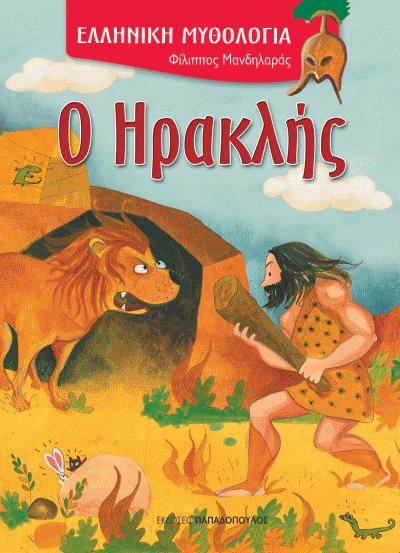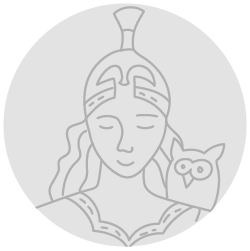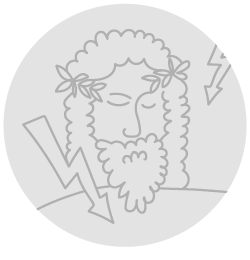Title of the work
Country of the First Edition
Country/countries of popularity
Original Language
First Edition Date
First Edition Details
Filippos Mandilaras, Ο Ηρακλής [O Īraklī́s], Greek Mythology [Ελληνική Μυθολογία (Ellīnikī́ Mythología)](Series). Athens: Papadopoulos Publishing, 2012, 16 pp.
ISBN
Genre
Myths
Target Audience
Children (Aged 4+)
Cover

Courtesy of the Publisher. Retrieved from epbooks.gr (accessed: July 5, 2022).
Author of the Entry:
Katerina Volioti, University of Roehampton, Katerina.Volioti@roehampton.ac.uk
Peer-reviewer of the Entry:
Susan Deacy, University of Roehampton, s.deacy@roehampton.ac.uk
Elżbieta Olechowska, University of Warsaw, elzbieta.olechowska@gmail.com

Natalia Kapatsoulia (Illustrator)
Natalia Kapatsoulia studied French Literature in Athens, and she worked as a language tutor before embarking on a career as a full-time illustrator of children’s books. Kapatsoulia has authored one picture book Η Μαμά πετάει [Mom Wants to Fly], which has been translated into Spanish Mamá quiere volar. Kapatsoulia, who now lives on the island of Kefalonia, Greece, has collaborated with Filippos Mandilaras on multiple book projects.
Sources:
Official website (accessed: July 2, 2018).
Profile at the epbooks.gr (accessed: July 2, 2018).
Bio prepared by Katerina Volioti, University of Roehampton, Katerina.Volioti@roehampton.ac.uk

Filippos Mandilaras
, b. 1965
(Author)
Filippos Mandilaras is a prolific and well-known writer of children’s illustrated books and of young adults’ novels. Mandilaras studied French Literature in Sorbonne, Paris. His latest novel, which was published in May 2016, is entitled Υπέροχος Κόσμος [Wonderful World], and it recounts the story of teenage life in a deprived Athenian district. With his illustrated books, Mandilaras aims to encourage parents and teachers to improvise by adding words when reading stories to children. Mandilaras is interested in the anthropology of extraordinary creatures and his forthcoming work is about Modern Greek Mythologies.
Sources:
In Greek:
Profile on EP Books' website (accessed: June 27, 2018).
i-read.i-teen.gr (accessed: June 27, 2018).
Public Blog, published 15 September 2015 (accessed: June 27, 2018).
Press Publica, published 28 January 2017 (accessed: June 27, 2018).
Linkedin.com, published published 6 May 2016 (accessed: February 6, 2019).
In English:
Amazon.com (accessed: June 27, 2018).
On Mandoulides' website, published 7 March 2017 (accessed: June 27, 2018).
In German:
literaturfestival.com (accessed: June 27, 2018).
Bio prepared by Katerina Volioti, University of Roehampton, Katerina.Volioti@roehampton.ac.uk
Adaptations
The book is an adaptation of the book published in 2008 within the series My First Mythology, published also in 2018 in English, French and Spanish:
Filippos Mandilaras, Ο Ηρακλής [O Iraklis], Athens: Papadopoulos Publishing, 2008, 36 pp.
Demo of 9 pages available at epbooks.gr (accessed: October 13, 2021).
Summary
At the very beginning of the book, we read about Herakles’ conception by Zeus and Alkmene. This affair made Hera jealous. Mandilaras presents Herakles’ labours in the following order: the Nemean Lion; the Lernean Hydra; the Erymanthean Boar; the Hind of Artemis; the Stymphalian Birds; the Augean Stables; the Cretan Bull; the Horses of Diomedes; the Belt of Hippolyte; Geryon's Cattle; the Cerberus; and the Apples of the Hesperides. Each labour is mentioned briefly, as is appropriate for young children. In some instances, as exemplified by the Augean Stables and the Cretan Bull, we have the text and combined imagery for two labours on one page.
In contrast to the maliciousness of Hera, Athena helps Herakles to kill the Stymphalian Birds. The gods compensate Herakles for his bravery, and instead of suffering a cruel death, he is granted immortality.
Analysis
Herakles is shown wearing a leopard’s skin throughout the book, and sometimes a lion’s skin appears on top of that. The leopard-skin depiction resembles the character Fred Flintstone from the well-known American TV series The Flintstones, although, as it is set in the Stone Age, this might cause some confusion.
Mandilaras’ text follows a rhyming pattern every two couplets. The language is simple and accessible, with a mixture of elevated and colloquial terms. The values merging from narrating Herakles’ labours include bravery, ingenuity, intelligence (for example, cleaning the stables), physical endurance, and agility. Herakles is strong in body and spirit, and he is not daunted by anything. For example, Herakles fights fiercely against the Amazons and in the darkness of Hades. These qualities are typical for the hero as he is depicted in ancient Greek mythology. Some of these qualities are mentioned directly in the text. For example, in cleaning the stables, it is stated that Herakles came up with a clever solution. Other qualities, such as strength and endurance, are implied rather than explicitly stated in the text.
The book does not finish just with the labours. Rather, we learn about Herakles’ softer side. Our hero can fall in love, and he is prepared to defend his love. Unfortunately, there is not a happy ending in the story. Nessos’ poison makes Herakles’ chiton cling to the hero’s body. Herakles is in pain. The gods intervene and take him to Olympus. On the final page, we see climbers up a mountain. Here, we appear to have a caricature of present-day mountaineers.
There are monstrous creatures in the story, like Diomedes’ flesh-eating horses. Yet, what we see in the illustration are benign-looking horses with hallows over their heads since Herakles has tamed them.
Women appear at the very beginning and towards the end of the story when we see the Amazons, the Hesperides, and Deianeira. Otherwise, the narrative befits a hyper-masculine hero, and masculine qualities predominate, such as physical strength. Moreover, Herakles’ bravery sometimes verges on savagery, e.g., the killing of the Lernean Hydra and Cerberus. Nevertheless, children will likely remember Herakles as a hero with extraordinary powers.
There is a strong visual narrative through Kapatsoulia’s captivating and humorous illustrations. Moving from one labour to the next, there are contrasting colours and landscapes. Kapatsoulia succeeds in creating the illusion that Herakles is in another place and time. The illustration for Herakles’ encounter with the Nemean lion, which is also featured on the book’s front page, is intriguing. The portrayal of the landscape is barren and dry, with a vivid yellow-orange colour dominating. There is possibly something Martian and cinematic here, potentially sparking children’s imagination beyond the realm of mythology.
Further Reading
Information about the book at epbooks.gr, published 16 March 2012 (accessed: July 31, 2018).


